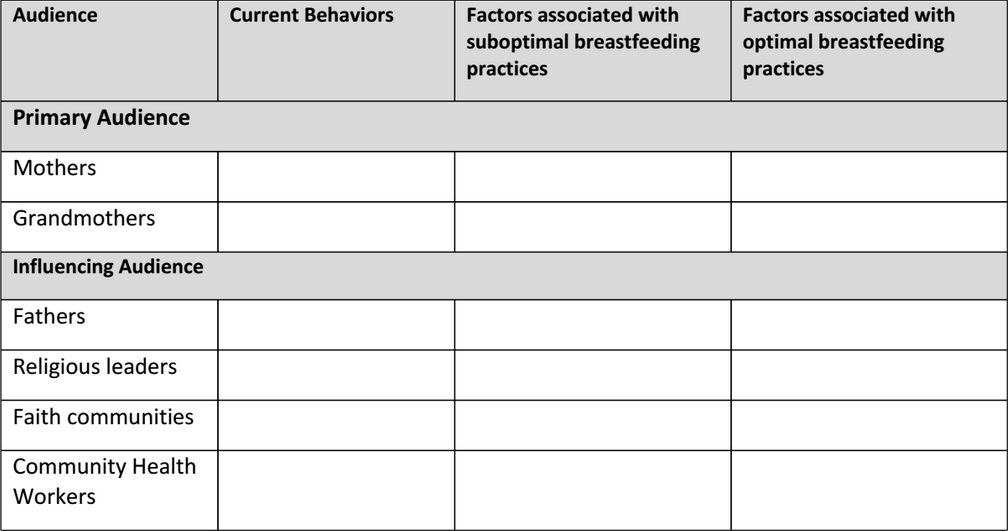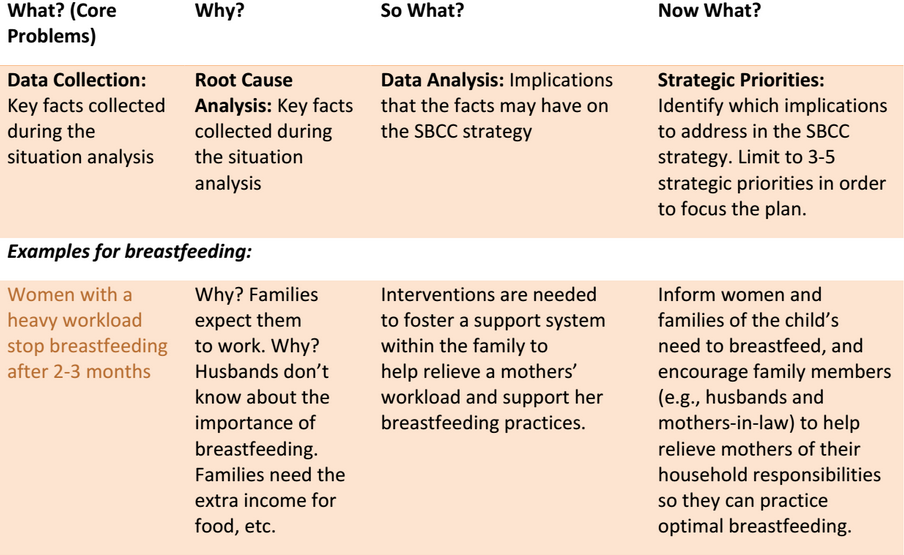What is a situation analysis?
A situation analysis is the systematic collection and study of information to identify trends, forces and conditions related to the problem you are trying to solve. In the case of SBCC, it will help you gain a deeper understanding of the opportunities, challenges and barriers to change. A situation analysis examines the people affected and their needs; social and cultural norms; potential constraints on individual and collective change; potential facilitators of individual and collective change; and the audiences’ access to and use of communication channels (such as brochures, television, and SMS). It also examines the status of the behavior in question, including the knowledge and practices of the audiences as well as policies that impact the behavior. In short, the situation analysis answers the question, “Where are we now?”
The situation analysis should help you answer five big questions:
- What is the child health situation here that demands a breastfeeding intervention?
- What are the current breastfeeding practices in this community/country?
- Where, with whom, and to what extent do feeding practices need to be changed?
- Who and what influence breastfeeding practices in the community/country?
- What are the best ways to reach priority groups with breastfeeding messages and interventions? (FBOs will want to be sure to identify faith-related assets they can use, such as religious texts and teachings, religious groups and leaders, groups within religious institutions such as women’s groups, men’s groups, religious broadcasts, and other available assets.)
[accordions]
[accordion title=”Why conduct a situation analysis?”]
A good situation analysis provides a detailed picture of the current state of the health problem or behavior you want to address. This information is crucial for making decisions about what the SBCC strategy will entail and how it will be implemented. Ultimately, it affects how successful the strategy is.[\accordions]
How to conduct a situation analysis
First, you will decide on a framework for presenting findings in a useful way. We have used a very simple framework to help focus the search for information:
Health and Breastfeeding Context
- Health context
- Breastfeeding context
Audience and Communication Analysis
- Individual, family, and community level
- Health level system
- Societal and political level
Figure 1. SBCC Situation Analysis Structure for breastfeeding.

Appendix C contains a comprehensive list of questions, organized according to the proposed framework, indicating the type of information you need in order to develop a successful SBCC strategy. When considering your own national or sub-national situation analysis, keep in mind that you should carefully select questions that meet the particular needs of the program and the region; as such, it is not necessary to use all of the sample questions listed.
Where to find information
Next, look at the information you already have or that is available from known sources. Save the Children’s Superfood for Babies and UNICEF’s Breastfeeding on the Worldwide Agenda provide global perspectives on commitment for and barriers to breastfeeding and some country-specific information.
For national information, the MOH might have a national breastfeeding policy that contains useful information on the state of breastfeeding in your country. Infant and young child feeding (IYCF) and RMNCH policies and guidelines may also provide information and analysis of the situation. You should also be able to get country-specific information from Demographic and Health Surveys (DHS) and Multiple Indicator Cluster Surveys (MICS). Also look for quantitative and qualitative research conducted by NGOs and Demographic Surveillance Sites, or private sector market research, where available, such as Neilsen. Some countries or country programs have employed national nutrition assessments.
How to find missing information
Now decide if you have all the information you need to develop a successful SBCC strategy, especially on the social and behavioral drivers of infant and young child feeding practices in your area. If you do not, decide how you will get the missing information. Typically this can involve a stakeholder consultation, focus groups and interviews with members of primary and influencing audiences and/or facility surveys (health, social service, religious or other facilities). Interviewing priority audiences and influencers is particularly helpful in identifying local beliefs and practices as well as the reasons for them. Sample interview and focus group questionnaires can be found in the I-Kit or at The Basics: Planning for Formative Research for Infant and Young Child Feeding Practices also provides formative research guidance and sample research tools.
How to use the situation analysis
Organize the situation analysis findings in a way that makes them easy to use and helps you focus on the most important information, as in Table 1, below. (This can actually be done as you gather the information.) Factors associated with optimal and suboptimal breastfeeding practices could be a combination of individual, family, community, and structural.
Table 1. Framework for organizing situation analysis findings
Finally, select only a few key factors from Table 1 that the SBCC strategy will address. While it is tempting to address all factors, successful communication programs focus on the factors that will have the biggest impact given available resources. In your setting, where are you likely to have the most impact? Household beliefs and practices? Breastfeeding mothers busy working at home and on the farm? No (or not enforced) active breastfeeding policy in health facilities? Breastfeeding knowledge and counseling skills of health staff and volunteers? Another area/topic?
Table 2 offers a series of questions to guide the selection of priorities to be addressed by the SBCC strategy. It helps you think through the implications of your findings and what you can do about them. When thinking about your core problems, continue to ask “why” these problems exist. For example, if one core problem to optimal breastfeeding is that, “Women with the heavy workload stop breastfeeding after 2-3 months,” ask why that is the case, and for each answer, ask “why” again until there is clarity on the root causes of the problem.
Table 2. Selection of strategic priorities
Source: Population Services International The DELTA Companion: Marketing Planning Made Easy.


